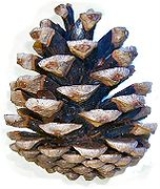
Conifer cone
Encyclopedia
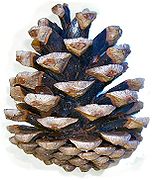
Plant
Plants are living organisms belonging to the kingdom Plantae. Precise definitions of the kingdom vary, but as the term is used here, plants include familiar organisms such as trees, flowers, herbs, bushes, grasses, vines, ferns, mosses, and green algae. The group is also called green plants or...
s in the division Pinophyta
Pinophyta
The conifers, division Pinophyta, also known as division Coniferophyta or Coniferae, are one of 13 or 14 division level taxa within the Kingdom Plantae. Pinophytes are gymnosperms. They are cone-bearing seed plants with vascular tissue; all extant conifers are woody plants, the great majority being...
(conifers) that contains the reproductive
Plant sexuality
Plant sexuality covers the wide variety of sexual reproduction systems found across the plant kingdom. This article describes morphological aspects of sexual reproduction of plants....
structures. The familiar woody cone is the female cone, which produces seeds
SEEDS
SEEDS is a voluntary organisation registered under the Societies Act of India....
. The male cones, which produce pollen
Pollen
Pollen is a fine to coarse powder containing the microgametophytes of seed plants, which produce the male gametes . Pollen grains have a hard coat that protects the sperm cells during the process of their movement from the stamens to the pistil of flowering plants or from the male cone to the...
, are usually herbaceous
Herbaceous
A herbaceous plant is a plant that has leaves and stems that die down at the end of the growing season to the soil level. They have no persistent woody stem above ground...
and much less conspicuous even at full maturity. The name "cone" derives from the fact that the shape in some species resembles a geometric
Geometry
Geometry arose as the field of knowledge dealing with spatial relationships. Geometry was one of the two fields of pre-modern mathematics, the other being the study of numbers ....
cone
Cone (geometry)
A cone is an n-dimensional geometric shape that tapers smoothly from a base to a point called the apex or vertex. Formally, it is the solid figure formed by the locus of all straight line segments that join the apex to the base...
. The individual plates of a cone are known as scales.
The male cone (microstrobilus or pollen cone) is structurally similar across all conifers, differing only in small ways (mostly in scale arrangement) from species to species. Extending out from a central axis are microsporophylls (modified leaves). Under each microsporophyll is one or several microsporangia
Sporangium
A sporangium is an enclosure in which spores are formed. It can be composed of a single cell or can be multicellular. All plants, fungi, and many other lineages form sporangia at some point in their life cycle...
(pollen sacs).
The female cone (megastrobilus, seed cone, or ovulate
Ovule
Ovule means "small egg". In seed plants, the ovule is the structure that gives rise to and contains the female reproductive cells. It consists of three parts: The integument forming its outer layer, the nucellus , and the megaspore-derived female gametophyte in its center...
cone) contains ovules which, when fertilized by pollen, become seeds. The female cone structure varies more markedly between the different conifer families, and is often crucial for the identification of many species of conifers.
Pinaceae cones

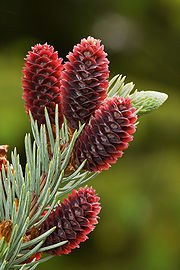
Pinaceae
Pinaceae are trees or shrubs, including many of the well-known conifers of commercial importance such as cedars, firs, hemlocks, larches, pines and spruces. The family is included in the order Pinales, formerly known as Coniferales. Pinaceae are supported as monophyletic by its protein-type sieve...
(pine
Pine
Pines are trees in the genus Pinus ,in the family Pinaceae. They make up the monotypic subfamily Pinoideae. There are about 115 species of pine, although different authorities accept between 105 and 125 species.-Etymology:...
s, spruce
Spruce
A spruce is a tree of the genus Picea , a genus of about 35 species of coniferous evergreen trees in the Family Pinaceae, found in the northern temperate and boreal regions of the earth. Spruces are large trees, from tall when mature, and can be distinguished by their whorled branches and conical...
s, fir
Fir
Firs are a genus of 48–55 species of evergreen conifers in the family Pinaceae. They are found through much of North and Central America, Europe, Asia, and North Africa, occurring in mountains over most of the range...
s, cedars, larch
Larch
Larches are conifers in the genus Larix, in the family Pinaceae. Growing from 15 to 50m tall, they are native to much of the cooler temperate northern hemisphere, on lowlands in the north and high on mountains further south...
es, etc.) have cones that are imbricate with scales overlapping each other like fish scales. These are the "archetypal" cones. The scales are spirally arranged in fibonacci number
Fibonacci number
In mathematics, the Fibonacci numbers are the numbers in the following integer sequence:0,\;1,\;1,\;2,\;3,\;5,\;8,\;13,\;21,\;34,\;55,\;89,\;144,\; \ldots\; ....
ratios.
The female cone has two types of scale: the bract scales, derived from a modified leaf, and the seed scales (or ovuliferous scales), one subtended by each bract scale, derived from a highly modified branchlet. On the upper-side base of each seed scale are two ovules that develop into seeds after fertilisation by pollen grains. The bract scales develop first, and are conspicuous at the time of pollination; the seed scales develop later to enclose and protect the seeds, with the bract scales often not growing further. The scales open temporarily to receive gametophytes, then close during fertilization and maturation, and then re-open again at maturity to allow the seed to escape. Maturation takes 6–8 months from pollination in most Pinaceae genera, but 12 months in cedars and 18–24 months (rarely more) in most pines. The cones open either by the seed scales flexing back when they dry out, or (in firs, cedars and golden larch
Pseudolarix
Pseudolarix is a monotypic genus in the family Pinaceae. The sole species, Pseudolarix amabilis is commonly known as Golden Larch, though it is not a true larch , being more closely related to Keteleeria, Abies and Cedrus...
) by the cones disintegrating with the seed scales falling off. The cones are conic
Cone (geometry)
A cone is an n-dimensional geometric shape that tapers smoothly from a base to a point called the apex or vertex. Formally, it is the solid figure formed by the locus of all straight line segments that join the apex to the base...
, cylindrical
Cylinder (geometry)
A cylinder is one of the most basic curvilinear geometric shapes, the surface formed by the points at a fixed distance from a given line segment, the axis of the cylinder. The solid enclosed by this surface and by two planes perpendicular to the axis is also called a cylinder...
or ovoid (egg-shaped), and small to very large, from 2–60 cm long and 1–20 cm broad.
After ripening, the opening of non-serotinous pine cones is associated with their moisture content—cones are open when dry and closed when wet. This assures that the small, wind disseminated seeds will be dispersed during relatively dry weather, and thus, the distance traveled from the parent tree will be enhanced. A pine cone will go through many cycles of opening and closing during its life span, even after seed dispersal is complete. This process occurs with older cones while attached to branches and even after the older cones have fallen to the forest floor
Forest floor
The forest floor, also called detritus, duff and the O horizon, is one of the most distinctive features of a forest ecosystem. It mainly consists of shed vegetative parts, such as leaves, branches, bark, and stems, existing in various stages of decomposition above the soil surface...
. The condition of fallen pine cones is a crude indication of the forest floor's moisture content, which is an important indication of wildfire
Wildfire
A wildfire is any uncontrolled fire in combustible vegetation that occurs in the countryside or a wilderness area. Other names such as brush fire, bushfire, forest fire, desert fire, grass fire, hill fire, squirrel fire, vegetation fire, veldfire, and wilkjjofire may be used to describe the same...
risk. Closed cones indicate damp conditions while open cones indicate the forest floor is dry.
Araucariaceae cones
Members of the AraucariaceaeAraucariaceae
Araucariaceae, commonly referred to as araucarians, is a very ancient family of coniferous trees. It achieved its maximum diversity in the Jurassic and Cretaceous periods, when it was distributed almost worldwide...
(Araucaria
Araucaria
Araucaria is a genus of evergreen coniferous trees in the family Araucariaceae. There are 19 extant species in the genus, with a highly disjunct distribution in New Caledonia , Norfolk Island, eastern Australia, New Guinea, Argentina, Chile, and southern Brazil.-Description:Araucaria are mainly...
, Agathis
Agathis
The genus Agathis, commonly known as kauri or dammar, is a relatively small genus of 21 species of evergreen tree. The genus is part of the ancient Araucariaceae family of conifers, a group once widespread during the Jurassic period, but now largely restricted to the Southern Hemisphere except for...
, Wollemia) have the bract and seed scales fully fused, and have only one ovule on each scale. The cones are spherical or nearly so, and large to very large, 5–30 cm diameter, and mature in 18 months; at maturity, they disintegrate to release the seeds. In Agathis, the seeds are winged and separate readily from the seed scale, but in the other two genera, the seed is wingless and fused to the scale.
Podocarpaceae cones
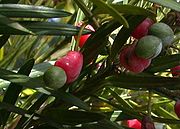
Podocarpaceae
Podocarpaceae is a large family of mainly Southern Hemisphere conifers, comprising about 156 species of evergreen trees and shrubs. It contains 19 genera if Phyllocladus is included and if Manoao and Sundacarpus are recognized....
are similar in function, though not in development, to those of the Taxaceae (q.v. below), being berry-like with the scales highly modified, evolved to attract bird
Bird
Birds are feathered, winged, bipedal, endothermic , egg-laying, vertebrate animals. Around 10,000 living species and 188 families makes them the most speciose class of tetrapod vertebrates. They inhabit ecosystems across the globe, from the Arctic to the Antarctic. Extant birds range in size from...
s into dispersing the seeds. In most of the genera, two to ten or more scales are fused together into a usually swollen, brightly coloured, soft, edible fleshy aril
Aril
An aril is any specialized outgrowth from the funiculus that covers or is attached to the seed. It is sometimes applied to any appendage or thickening of the seed coat in flowering plants, such as the edible parts of the mangosteen and pomegranate fruit, the mace of the nutmeg seed, or the...
. Usually only one or two scales at the apex of the cone are fertile, each bearing a single wingless seed, but in Saxegothaea
Saxegothaea
Saxegothaea is a genus comprising a single species of conifer belonging to the podocarp family Podocarpaceae, its full scientific name is Saxegothaea conspicua, native to southern South America...
several scales may be fertile. The fleshy scale complex is 0.5–3 cm long, and the seeds 4–10 mm long. In some genera (e.g. Prumnopitys
Prumnopitys
Prumnopitys is a genus of conifers belonging to the podocarp family Podocarpaceae. The eight recognised species of Prumnopitys are densely-branched, dioecious evergreen trees up to 40 metres in height. The leaves are similar to those of the yew, strap-shaped, 1-4 cm long and 2-3 mm broad, with a...
), the scales are minute and not fleshy, but the seed coat develops a fleshy layer instead, the cone having the appearance of one to three small plum
Plum
A plum or gage is a stone fruit tree in the genus Prunus, subgenus Prunus. The subgenus is distinguished from other subgenera in the shoots having a terminal bud and solitary side buds , the flowers in groups of one to five together on short stems, and the fruit having a groove running down one...
s on a central stem. The seeds have a hard coat evolved to resist digestion in the bird's stomach, and are passed in the bird's droppings.
Cupressaceae cones
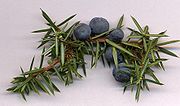
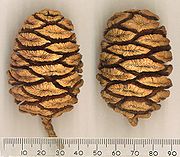
Cupressaceae
The Cupressaceae or cypress family is a conifer family with worldwide distribution. The family includes 27 to 30 genera , which include the junipers and redwoods, with about 130-140 species in total. They are monoecious, subdioecious or dioecious trees and shrubs from 1-116 m tall...
(cypresses
Cupressus
The genus Cupressus is one of several genera within the family Cupressaceae that have the common name cypress; for the others, see cypress. It is considered a polyphyletic group...
, arborvitae
Thuja
Thuja is a genus of coniferous trees in the Cupressaceae . There are five species in the genus, two native to North America and three native to eastern Asia...
, juniper
Juniper
Junipers are coniferous plants in the genus Juniperus of the cypress family Cupressaceae. Depending on taxonomic viewpoint, there are between 50-67 species of juniper, widely distributed throughout the northern hemisphere, from the Arctic, south to tropical Africa in the Old World, and to the...
s, redwoods, etc.) differ in that the bract and seed scales are fully fused, with the bract visible as no more than a small lump or spine on the scale. The botanical term galbulus (plural galbuli; from the Latin
Latin
Latin is an Italic language originally spoken in Latium and Ancient Rome. It, along with most European languages, is a descendant of the ancient Proto-Indo-European language. Although it is considered a dead language, a number of scholars and members of the Christian clergy speak it fluently, and...
for a cypress cone) is sometimes used instead of strobilus for members of this family. The female cones have one to 20 ovules on each scale. They often have peltate scales, as opposed to the imbricate cones described above, though some have imbricate scales. The cones are usually small, 0.3–6 cm long, and often spherical or nearly so, like those of Nootka Cypress
Callitropsis nootkatensis
Nootka Cypress , formerly Cupressus nootkatensis, Xanthocyparis nootkatensis or Chamaecyparis nootkatensis, is a cypress with a chequered taxonomic and nomenclatural history. This species goes by many common names including Nootka Cypress, Yellow Cypress, and Alaska Cypress...
, while others, such as Western Redcedar
Thuja plicata
Thuja plicata, commonly called Western or pacific red cedar, giant or western arborvitae, giant cedar, or shinglewood, is a species of Thuja, an evergreen coniferous tree in the cypress family Cupressaceae native to western North America...
, are narrow. The scales are arranged either spirally, or in decussate whorls of two (opposite pairs) or three, rarely four. The genera with spiral scale arrangement were often treated in a separate family (Taxodiaceae) in the past. In most of the genera, the cones are woody and the seeds have two narrow wings (one along each side of the seed), but in three genera (Platycladus
Platycladus
Platycladus is a distinct genus of evergreen coniferous tree in the cypress family Cupressaceae, containing only one species, Platycladus orientalis, also known as Chinese Arborvitae or Biota. It is endemic to Northwestern China...
, Microbiota
Microbiota
Microbiota is a monotypic] genus of evergreen coniferous shrub in the cypress family Cupressaceae, containing only one species, Microbiota decussata...
and Juniperus), the seeds are wingless, and in Juniperus, the cones are fleshy and berry
Berry
The botanical definition of a berry is a fleshy fruit produced from a single ovary. Grapes are an example. The berry is the most common type of fleshy fruit in which the entire ovary wall ripens into an edible pericarp. They may have one or more carpels with a thin covering and fleshy interiors....
-like.
Sciadopityaceae cones
The cones and seeds of SciadopitysSciadopitys
The Koyamaki , or Japanese Umbrella-pine, is a unique conifer endemic to Japan. It is the sole member of the family Sciadopityaceae and genus Sciadopitys, a living fossil with no close relatives, and known in the fossil record for about 230 million years.Its genus name comes from the Greek prefix...
(the only member of the family) are similar to those of some Cupressaceae, but larger, 6–11 cm long; the scales are imbricate and spirally arranged, and have 5-9 ovules on each scale.
Taxaceae and Cephalotaxaceae cones

Taxaceae
The family Taxaceae, commonly called the yew family, includes three genera and about 7 to 12 species of coniferous plants, or in other interpretations , six genera and about 30 species....
and the closely related Cephalotaxaceae
Cephalotaxaceae
The family Cephalotaxaceae is a small grouping of conifers, with three genera and about 20 species, closely allied to the Taxaceae, and included in that family by some botanists. They are restricted to east Asia, except for two species of Torreya found in the southwest and southeast of the USA;...
have the most highly modified cones of any conifer. There is only one scale in the female cone, with a single poisonous ovule. The scale develops into a soft, brightly coloured sweet, juicy, berry-like aril which partly encloses the deadly seed. The seed alone is poisonous. The whole 'berry' with the seed is eaten by birds, which digest the sugar
Sugar
Sugar is a class of edible crystalline carbohydrates, mainly sucrose, lactose, and fructose, characterized by a sweet flavor.Sucrose in its refined form primarily comes from sugar cane and sugar beet...
-rich scale and pass the hard seed undamaged in their droppings, so dispersing the seed far from the parent plant.
Location and distribution
For most species, male and female cones occur on the same plant (treeTree
A tree is a perennial woody plant. It is most often defined as a woody plant that has many secondary branches supported clear of the ground on a single main stem or trunk with clear apical dominance. A minimum height specification at maturity is cited by some authors, varying from 3 m to...
or shrub
Shrub
A shrub or bush is distinguished from a tree by its multiple stems and shorter height, usually under 5–6 m tall. A large number of plants may become either shrubs or trees, depending on the growing conditions they experience...
), with female usually on the higher branches towards the top of the plant. This distribution is thought to improve chances of cross-fertilization
Cross-fertilization
Cross-fertilization can refer to:*Allogamy, where an ovum from one individual is fertilized with the spermatozoa of another*Heterosis, where different strains are cross-bred to form a hybrid...
, as pollen is unlikely to be blown vertically upward within the crown of one plant, but can drift slowly upward in the wind, blowing from low on one plant to higher on another plant. In some conifers, male cones additionally often grow clustered in large numbers together, while female cones are more often produced singly or in only small clusters.
A further characteristic arrangement of pines is that the male cones are located at the base of the branch, while the female at the tip (of the same or a different branchlet). However, in larches and cedars, both types of cones are always at the tips of short shoots, while both sexes of fir cones are always from side buds, never terminal. There's also some diversity in bearing in Cupressaceae. Some, Cupressus
Cupressus
The genus Cupressus is one of several genera within the family Cupressaceae that have the common name cypress; for the others, see cypress. It is considered a polyphyletic group...
for instance, has little or no differentiation in the positions of male and female cones.
Pseudocones

Norway Spruce
Norway Spruce is a species of spruce native to Europe. It is also commonly referred to as the European Spruce.- Description :...
and Sitka spruce
Sitka Spruce
Picea sitchensis, the Sitka Spruce, is a large coniferous evergreen tree growing to 50–70 m tall, exceptionally to 95 m tall, and with a trunk diameter of up to 5 m, exceptionally to 6–7 m diameter...
are prone to the formation of Pineapple gall pseudocones caused by the woolly aphid, Adelges abietis. These are not cones, although they closely resemble them.
Alder
Alder
Alder is the common name of a genus of flowering plants belonging to the birch family . The genus comprises about 30 species of monoecious trees and shrubs, few reaching large size, distributed throughout the North Temperate Zone and in the Americas along the Andes southwards to...
trees are not even conifers, however the mature seed bearing structures closely resemble cones.
Cultural uses of cones
Because of their widespread occurrence, conifer cones have been a traditional part of the arts and craftsArts and crafts
Arts and crafts comprise a whole host of activities and hobbies that are related to making things with one's hands and skill. These can be sub-divided into handicrafts or "traditional crafts" and "the rest"...
of cultures where conifers are common. Examples of their use includes seasonal wreaths and decorations, fire starters, bird feeders, toys, etc. An intriguing derivation of the impossible bottle
Impossible bottle
An impossible bottle is a type of mechanical puzzle. It is a bottle that has an object inside it that does not appear to fit through the mouth of the bottle. The objects inside authentic impossible bottles must always go through the neck. The glass cannot be cut or blown around the objects.The ship...
mechanical puzzle
Mechanical puzzle
A mechanical puzzle is a puzzle presented as a set of mechanically interlinked pieces.- History :The oldest known mechanical puzzle comes from Greece and appeared in the 3rd century BC....
takes advantage of the fact that pine
Pine
Pines are trees in the genus Pinus ,in the family Pinaceae. They make up the monotypic subfamily Pinoideae. There are about 115 species of pine, although different authorities accept between 105 and 125 species.-Etymology:...
cones open and close based on their level of dryness. In constructing the pine cone in the bottle display, a closed, damp cone of suitable size is inserted into a narrow-mouthed bottle and allowed to open upon drying.
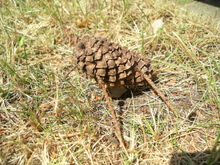
Toy
A toy is any object that can be used for play. Toys are associated commonly with children and pets. Playing with toys is often thought to be an enjoyable means of training the young for life in human society. Different materials are used to make toys enjoyable and cuddly to both young and old...
s, made by children using material found in nature. The most common design is a spruce
Spruce
A spruce is a tree of the genus Picea , a genus of about 35 species of coniferous evergreen trees in the Family Pinaceae, found in the northern temperate and boreal regions of the earth. Spruces are large trees, from tall when mature, and can be distinguished by their whorled branches and conical...
or pine
Pine
Pines are trees in the genus Pinus ,in the family Pinaceae. They make up the monotypic subfamily Pinoideae. There are about 115 species of pine, although different authorities accept between 105 and 125 species.-Etymology:...
cone with sticks or match
Match
A match is a tool for starting a fire under controlled conditions. A typical modern match is made of a small wooden stick or stiff paper. One end is coated with a material that can be ignited by frictional heat generated by striking the match against a suitable surface...
es for legs, which can easily be attached by forcing them between the cone scales. Playing with cone cows often includes building an animal enclosure from sticks. For the most part, cone cows have been displaced by manufactured toys, at least in affluent countries, but the creation of cone cows still enjoys some popularity as an outdoor activity for children.
Cone cows are a part of children's culture in Finland
Finland
Finland , officially the Republic of Finland, is a Nordic country situated in the Fennoscandian region of Northern Europe. It is bordered by Sweden in the west, Norway in the north and Russia in the east, while Estonia lies to its south across the Gulf of Finland.Around 5.4 million people reside...
where they are known as Käpylehmä (plural: Käpylehmät) and Sweden
Sweden
Sweden , officially the Kingdom of Sweden , is a Nordic country on the Scandinavian Peninsula in Northern Europe. Sweden borders with Norway and Finland and is connected to Denmark by a bridge-tunnel across the Öresund....
where they are known as kottkor or kottdjur (cone animals). Schools and other institutions teach children how to make cone cows as part of outdoors education on nature and history.
In Finland there is a fairground with cone cow sculptures large enough for children to ride on. In Sweden, a video game was released in which the player may build virtual cone cows. Swedish artist Lasse Åberg
Lasse Åberg
Lars Gunnar Åberg , better known as Lasse Åberg, is a Swedish actor, musician, film director and artist. He was born in the small town Hofors, but grew up in Stockholm...
has created artwork with cone cows, which has been included in an alphabet book
Alphabet book
An Alphabet book is a book primarily designed for young children. It presents letters of the alphabet with corresponding words and/or images. Some alphabet books feature capitals and lower case letter forms, keywords beginning with specific letters, or illustrations of keywords...
and featured on a Swedish postage stamp
Postage stamp
A postage stamp is a small piece of paper that is purchased and displayed on an item of mail as evidence of payment of postage. Typically, stamps are made from special paper, with a national designation and denomination on the face, and a gum adhesive on the reverse side...
among other classic toys.
External links
- Arboretum de Villardebelle Images of various conifer-cones
- Gymnosperm cone images at bioimages.vanderbilt.edu

